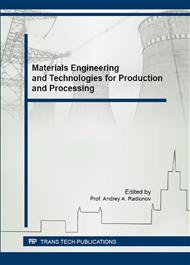p.3
p.10
p.16
p.22
p.28
p.34
p.39
p.46
p.52
Creep and Long-Term Strength of Molybdenum Alloy
Abstract:
Mechanical behavior of a molybdenum alloy for high-temperature application was investigated at monotonic loading up to fracture, stress-and strain-controlled cyclic loading and short-term creep (less than 9 hours) under the temperatures from 293 to 1773 K using Gleeble-3800 physical simulator. The tests show that plastic strain corresponding to the tensile strength of the material under monotonic loading is small enough (<1%) whereas residual plastic strain after fracture exceeds by 50%. Repeated loading decreases the tensile strength and yield stress, but increases stable (rising) part of stress-strain curve. Increase in the test temperature leads to the change in fracture type from ductile to quasi-brittle distributed at a temperature above 1673 K. Under relatively low temperatures the rheological properties of the material depend strongly on the material processing history. Obtained creep data allows putting up a thermo-activational type equation used to calculate the steady creep rate. Coupling with the known Hoff's model for the creep prefracture stage, this equations allow not only strain rate but also adequate estimation of fracture time.
Info:
Periodical:
Pages:
28-33
Citation:
Online since:
February 2016
Authors:
Keywords:
Price:
Сopyright:
© 2016 Trans Tech Publications Ltd. All Rights Reserved
Share:
Citation:


